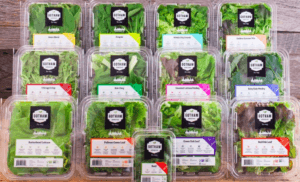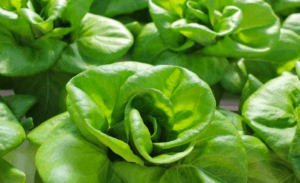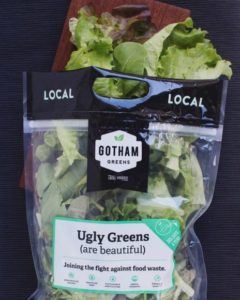Gotham Greens: Transforming the Produce Supply Chain

Founded in 2009, Gotham Greens is the largest urban agriculture company in the world. Can Gotham continue to refine and grow its hyper-local, hydroponic farming model and become the new agricultural mainstream in the US?
In 2009, Viraj Puri and Eric Haley founded Gotham Greens, an innovative urban agriculture company focusing on “hyper-local, premium-quality, greenhouse grown vegetables and herbs.”[1] Gotham Greens currently operates over 170,000 square feet of hydroponic growing facilities in urban areas, including the world’s largest rooftop greenhouse at 75,000 square feet located in Chicago.
Combatting climate change is at the heart of Gotham’s mission. By growing produce for hyper-local consumption, transportation-related fuel consumption and food wastage is practically eliminated. Gotham’s facilities run year-round, are powered by 100% renewable energy and feature energy-saving mechanisms such as lighting and ventilation controls. All irrigation water is 100% recycled and enclosing the growing space protects the produce from harsh weather conditions and the damaging effects of climate change itself.[2]
Hydroponics is the foundation of Gotham’s innovative growing practices. In a hydroponic system, nutrients are dissolved into water that is fed directly to the plants. This method can produce 20-30 times as many crops per acre as a conventional farm. Without the need for nitrogen-based fertilizers, hydroponic systems do not produce ground-contaminating runoff or contribute to greenhouse gas emissions.[3] Because hydroponic systems do not use soil, they are lightweight and can be installed in large rooftop arrays, making them well-suited to the built-up fabric of major cities.
Gotham is now the largest urban agriculture company in the world, but having moved beyond the proof-of-concept stage, the business now faces new challenges as it pursues its goal of expansion throughout the US. As an operation with high fixed costs that cannot be easily spread across facilities, Gotham faces new logistical and regulatory challenges with every new location.[4] Industrial farms still hold the lion’s share of the produce market in the US and every day more hydroponic growing startups such as BrightFarms and Aerofarms are entering the market.[5]
One of the ways Gotham is staying ahead of the pack is by increasing its product offerings. New lettuces and specialty basils are being grown in addition to the preexisting lineup of tomatoes and basic greens. Gotham is introducing a line of packaged foods, including a pesto made from its Genovese basil. The company has also begun to roll out a program it calls Ugly Greens: selling bags of slightly blemished lettuces alongside its regular products at a discount. The program is intended to call attention to the global issue of food wastage and has experienced early success.[6] All these new products will increase the complexity of Gotham’s supply chain but may also offer operational synergies with its original product mix.
Taking advantage of recent technological innovations in distribution is one way for Gotham to fuel its growth. Full Harvest, for example, is a company that runs an online B2B marketplace for the same “surplus and imperfect” produce that Gotham is selling through Ugly Greens.[7] The direct-to-consumer model may also represent untapped potential for Gotham. In 2015, the USDA released a report about local and regional food systems, indicating that the number of farms with DTC models “increased by 17 percent between 2002 and 2007 and another 5.5 percent between 2007 and 2012.”[8] Gotham already sells directly through its partnerships with local chefs and restaurants, but with the recent proliferation of technology-enabled delivery services, there will likely be new DTC opportunities in the near future.
Gotham should also take advantage of the numerous startups that are leveraging digital technology to optimize agricultural production. Companies such as Granular and AgCode use advanced data processing to allow farmers to precisely monitor their entire crop, giving them instant visibility into resource consumption, production levels and even staffing and profitability. Other firms such as Mavrx and Farmer’s Edge use satellite imagery to identify, assess and manage farmland variability. Although satellites imagery does not apply to Gotham’s enclosed growing environment, the use of advanced imaging more generally may provide valuable insight into the effects of various cultivation techniques on plant performance. There are even blockchain and big data companies such as RipeIO and the Farmer’s Business Network that help small farms use analytics to compete with larger operations.[9]
The growth potential for Gotham Greens and other urban agriculture businesses is substantial. If these companies can develop a wide range of products, capitalize on new modes of distribution and integrate new digital technologies, the increasing demand for locally-grown, sustainable produce will sustain them for many years to come. The question of whether these operations can go head-to-head with corporate farming, however, remains to be answered. If Gotham Greens can take on the industrial farm, the company may provide an agricultural solution not just for the US but for every country in which farmers are struggling to cope with the effects of climate change.
(776 words)
[1] Gotham Greens, http://gothamgreens.com, accessed November 2017.
[2] Christine Escobar, “World’s Largest Rooftop Farm Opens on the South Side of Chicago,” https://www.huffingtonpost.com/christine-escobar/worlds-largest-rooftop-fa_b_8715554.html, accessed November 2017.
[3] Ashleigh Schmitz Morley, “Take a Peek Inside the World’s Largest Rooftop Greenhouse,” https://weather.com/holiday/spring/news/chicago-rooftop-greenhouse-worlds-largest, accessed November 2017.
[4] Bond Street, “In the (Green) House: Gotham Greens,” https://bondstreet.com/blog/gotham-greens, accessed November 2017.
[5] Lisa Elaine Held, “How Urban Farms Are Changing the Way We Eat,” https://www.eater.com/2016/4/12/11394458/urban-farm-greenhouse-brooklyn-chicago, accessed November 2017.
[6] Bridget Shirvell, “Gotham Greens Wants to Sell You Ugly Lettuce,” https://www.ediblebrooklyn.com/2016/gotham-greens-wants-to-sell-you-ugly-lettuce, accessed November 2017.
[7] Full Harvest, https://fullharvest.com, accessed November 2017.
[8] Held, “How Urban Farms Are Changing the Way We Eat.”
[9] Chloe Sorvino, “The 25 Most Innovative Ag-Tech Startups,” https://www.forbes.com/sites/maggiemcgrath/2017/06/28/the-25-most-innovative-ag-tech-startups/#1274c85b4883, accessed November 2017.











Gotham Greens at a crossroads when it comes to achieving scale. There is an inherent tension in their branding, which is local/sustainable and a desire to take on big agriculture. One question is whether they might want to consider partnering with one of the large agriculture businesses that control production in the U.S. to achieve scale. Such a partner might have the resources to cover Gotham’s high fixed costs and add supply chain expertise that would enable them to reach new markets. Another possible path to scale is selling their technology to such companies and establishing hydroponic facilities outside of urban areas at a cheaper cost. Finally, for double bottom line businesses like Gotham, there is a question of whether they might be able to address challenges like urban poverty and decay through their business model.
This is a very interesting conundrum that companies like Gotham Greens face, especially as they try to scale to tackle larger incumbents. How do they stay true to their organic knitting? However, I am truly optimistic on the ability of blockchain to allow Gotham Greens to take on the agri behemoths, by precisely enabling them to stick to their knitting.
First, big agriculture often looses credentials on the “organic” labeling front, because they are either not able to claim that their whole sourcing chain is organic or because the chain is simply not organic. Blockchain utilization allows companies to track all aspects of their supply chain and allows customers full transparency into their product – from seed to store shelf. This allows for transparency not only on the organic-labeling side but also in terms of fair wage practices.
Second, blockchain allows companies like Gotham Greens to scale through financing. Traditionally, big agri has benefited from being able to purchase and sell on credit. It often takes months if not seasons for money to come through to a farm after fertilization. Blockchain allows for immediate transactions and real-time payment on delivery, with farmers being paid instantly through the blockchain by providing transparency to end consumers.
https://agfundernews.com/from-bitcoin-to-agriculture-how-can-farmers-benefit-from-blockchain6380.html
Ryu, thanks for your essay – it was very insightful! I see grate potential for companies like Gotham Greens join “organic” trend but there are also three points I would like to share my opinion on as open questions for further success:
1. Using of other startups as a competitive advantage
There are a lot of potential for Gotham Greens in using cutting edge technologies (like Rhonda’s idea on on delivery payment what is great) but I have a strong feeling that large corporation can currently leverage these technologies more efficient and become even more powerful even without mentioning possibility for acquisition for these startups. For example, some ex-Googlees from Russia once have tried to use basic maps for satellite imagery technology you have mentioned. Even it was somehow successful the real efficient technology has requested HQ images from professional space cameras what is very expensive (advantage for big corporations) and limited for some geographies (question of further movement to the new markets).
2. Potential of DTC model
You have mentioned that current buyers of Gotham Greens are mostly B2B (HoReCa and I assume small local retailers) with some level of forecasting. Pace of growth has declined (17% and 5,5%), so movement to B2C is extremely critical what might be inventory risky on small scales. As at the first question I see also a potential for large companies to grab this market. Kellogg or Gillette already provides DTC model and for agriculture sector it is only the question of time and GM decisions. There are also some startups which consolidate volumes from different large manufacturers to achieve logistic synergies and a cooperation with widely spread famous brands is much easier and efficient at the beginning. One of the parallel effect will be increasing cost of customer acquisition what might be tough for small companies.
3. Synergy with non-core business (such as packaged pesto)
Even wider assortment supports DTC model it still requires a lot of CAPEX what consequently limits production synergy only for big Gotham Greens facilities. The same time the sustainability of greenhouses and plants for packaged goods is very different exercises what can be critical for Gotham Greens brand.
I found this report very interesting in the context of urban population explosion and sustainability issue in the developing countries.
However, profitability and scalability of hydroponic farming is the biggest challenge. I propose to add more premium to hydroponic farming products by combining it with other services for urban population in advanced countries. For example, paid service for urban family to participate in urban hydroponic farming in their local community and also cooking classes might be a premium experience for them. Urban rich family might also be interested in financially supporting hydroponic farming in developing countries by allocating a part of their participation fees to these countries, where water resources are scarce and fresh vegetables are mostly imported rather that transported from rural farms due to lack of efficient transportation and infrastructure.
As the essay puts it, the key problem that Gotham is trying to solve is reducing climate change, by reducing the carbon footprint caused by the transportation of produce from farmers to consumption centers (i.e. cities) and by reducing food waste, and I believe that the original business proposed by Gotham, the well-localized facilities, definitely attacks those two points, but specially the first one. I would argue, however, that producing the packaged goods, such as the pesto, does not really help any of those points unless they can manufacture ready-to-use pesto in a more eco-friendly way than any other competitor, which does not seem to be their core capability. Therefore, I believe Gotham should let this business aside and keep focusing on initiatives that will reduce climate change. Having said that, I see an enormous potential in the Ugly Greens initiative.The amount of food that is wasted just because some vegetables don’t look so good is unbelievable. Along those lines, it would also be interesting to think how the direct to consumer approach mentioned by the essay could be leveraged to reduce waste, since every single day an enormous quantity of fruits and vegetables are wasted by big supermarket chains, just because it is impossible to perfectly match supply and demand. That is a problem that could potentially be solved if consumers would order individually because there would be such a better visibility of the actual demand.